

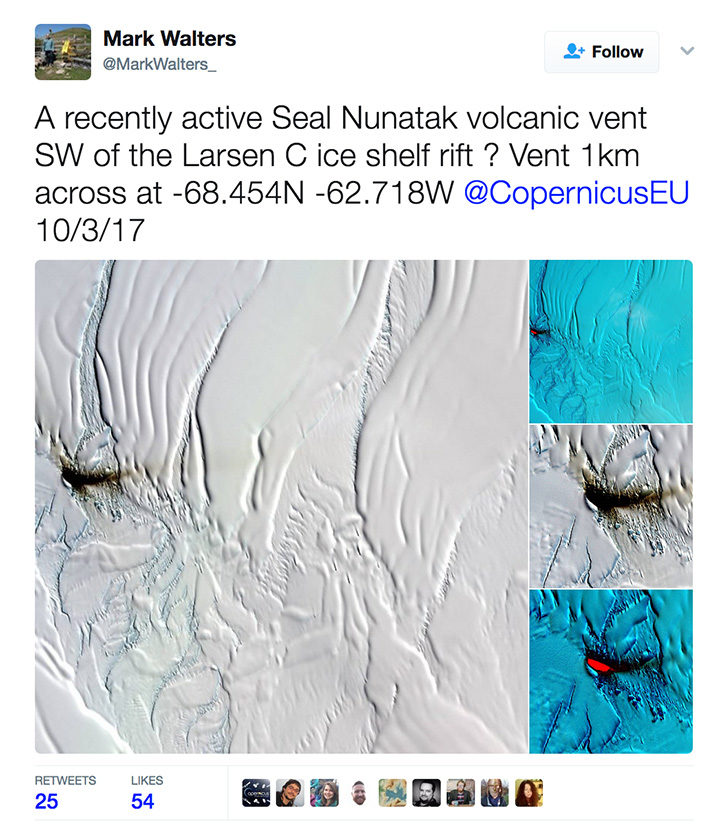
On April 4, 2017, archaeologist Mark Walters tweeted an intriguing set of satellite images of a dark smear on the Larsen C Ice Shelf. Was it volcanic ash from a recently active volcanic vent, he wondered?
The tweet — and especially a bright, red spot in an infrared image (lower right in the screenshot) — generated interest among folks who follow Earth science, Antarctica, and volcanoes. New volcanic activity in this area would be surprising and newsworthy. While there is some evidence of volcanic activity near this part of the Larsen Ice Shelf, the most recent reports date back to 1980.
Some remote sensing experts who saw the images were skeptical. “I looked through about four months of satellite images before/after and never saw anything that resembled a plume. Think it’s dust on ice,” tweeted Erik Klemetti, an associate professor at Denison University and author of Wired’s Eruptions blog.
Later, CNRS scientist Simon Gascoin weighed in, noting that the underlying geology in that area was sedimentary rock—a sign that volcanic activity wasn’t likely. Then he shared even stronger evidence against the idea of volcanic activity.
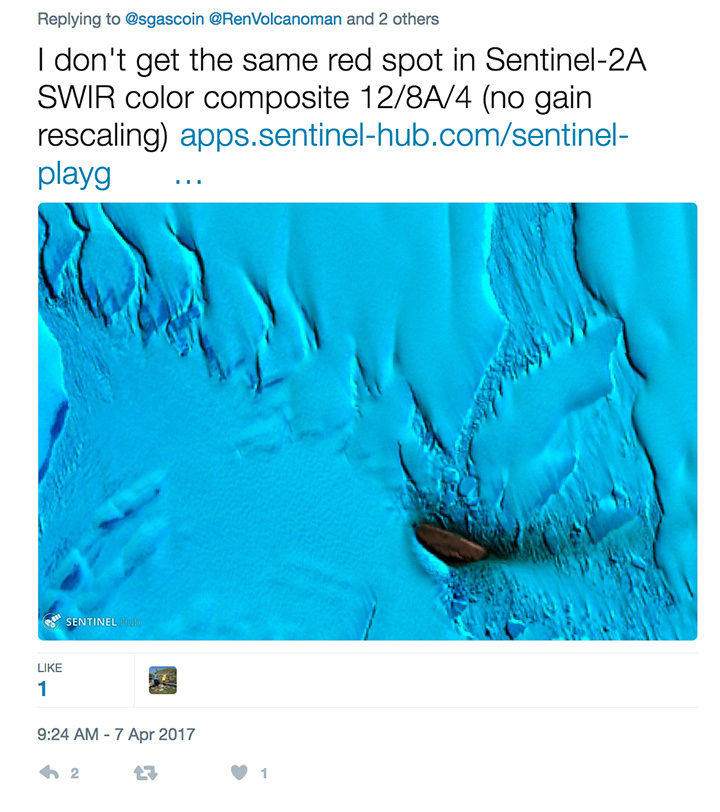
In an email, I asked Gascoin to clarify what he meant by “no gain rescaling” and why his image from the Sentinel Playground looked so different in comparison to the image from Land Viewer.
His reply: “Mark Walters used the Land Viewer, I just checked and found out that the ‘contrast stretching‘ is computed on each RGB band separately. Hence you can get strange results, especially in cases where a single rock island is surrounded by snow and ice which have a very distinct reflectance signature.”
In other words, Gascoin is saying that the image-processing algorithm that drives the Land Viewer browser amplified the reflectance signal from the dust in a way that made it appear stronger in the infrared than it actually was. Sentinel Playground uses a different image processing approach (adjusting the contrast of the image “bands” all at once rather than individually) to avoid the problem.

Satellite instruments carry many sensors that are each tuned to a narrow range, or “band,” of wavelengths (just red or green light, for instance). This chart shows how the bands of sensors on the Sentinel-2, Landsat 7, and Landsat 8 satellites compare. To make a satellite image, three different bands are represented in tones of red, green, or blue. A false-color image uses at least one non-visible wavelength, though that band is still represented in red, green, or blue. Read this story to learn more about how observations made in the infrared are displayed in false-color images.
Meanwhile, experts from the Smithsonian’s Global Volcanism Program had arrived at a similar conclusion. “It seems unlikely that this is an eruption for a few reasons,” emailed Benjamin Andrews. “First, Table Nunatak is formed of Cretaceous rocks, with no evidence of recent activity. Second, it is located pretty far from any other volcanoes, and there doesn’t appear to be a good tectonic explanation for current magmatism at Table Nunatak.”
So, the mystery appears to be solved. As interesting as it would have been, there is no new volcanic activity happening in this part of Larsen C.
Bigger isn’t necessarily better—at least where satellites are concerned. Modern “CubeSat” satellites are smaller and more numerous than ever.
The CubeSat takes its name from its dimensions; it is made up of multiples of 10×10×11 centimeter cubic units. A basic CubeSat weighs roughly 3 pounds (1.3 kilograms) and looks a good deal like a portable speaker.
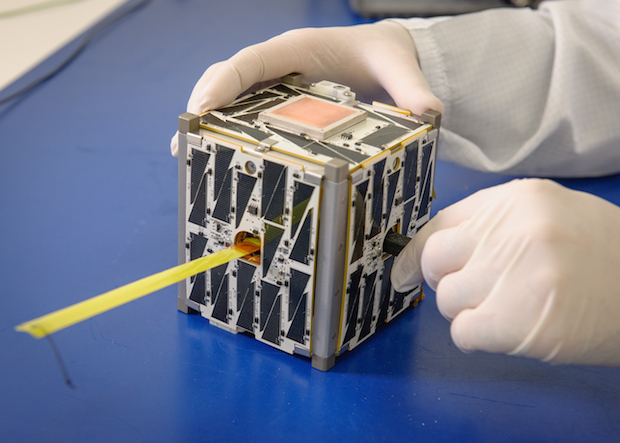
Image by NASA Ames.
BACK TO THEIR ROOTS
Early satellites started out small, too. Launched in 1957, Sputnik weighed around 184 pounds (83 kilograms). America’s first satellite, Explorer I, weighed just under 31 lbs (14 kg). Then, as the desire for more sensors grew, so did the size of satellites. The first American weather satellite, TIROS I, was a hefty 270 lbs (122 kg). But recent years have seen a reversal of this trend.

Explorer I. Image by NASA.
Like modern cell phones, satellites have benefited from more compact and more powerful computing technology. (A 1980s cell phone was an expensive, brick-sized gadget that could only place phone calls and store a couple dozen numbers.) Satellites, too, have sprouted new cameras and sensors. Take the IPEX CubeSat developed by NASA’s Jet Propulsion Laboratory (45 seconds into the video below); it can track features like forest fires, volcanic eruptions, and algae blooms.
THE UPSIDES OF BEING SMALL
A satellite today can be a “hitchhiker,” aboard a larger mission, as the video below mentions. Or, a CubeSat can be launched from the International Space Station.
Because they are smaller, CubeSats tend to cost less, so research organizations can deploy more of them. That means more spatial coverage for monitoring the Earth. Where researchers once relied on two or three larger satellites to keep an eye on weather over the Pacific Ocean, now, handfuls of smaller satellites can help with the job.
NASA is not the only organization that builds CubeSats. The space agency has delivered little satellites made by private companies, college students, and even grade school students.
To learn more, watch the video below. Or read more here.

NASA/EO-1/ALI/Jesse Allen and Robert Simmon. More info about this image here.
Four years ago today, one of the largest non-volcanic landslides in U.S. history began high on the northern wall of Utah’s Bingham Canyon mine. During two main bursts of activity that day, several million cubic meters of rock and soil careened deep into the mine’s pit.
This was a case where science and the right preparation saved lives. The company that runs the mine had installed an interferometric radar system months before the slide, and it prevented miners from being blindsided. With the radar system in place, mine operators detected changes in the stability of the pit’s walls well before the landslide occurred. When the slope finally gave way, all the workers in the pit had already been evacuated. Not one person was injured.
The image above was acquired by the Advanced Land Imager (ALI) on the Earth Observing-1 satellite on May 2, 2013. For more detailed and recent images of the mine pit, see the montage below. Photos A, B, and C — from Rio Tinto Kennecott — show an overview of the pit, the source area, and slide debris in the immediate aftermath of the event. D is an aerial image from the state government of Utah that shows the mine nine months before the landslide. E is part of the ALI satellite image above. F is a second aerial image taken in February 2014. By then, much of the debris had been removed and a new access road had been built.
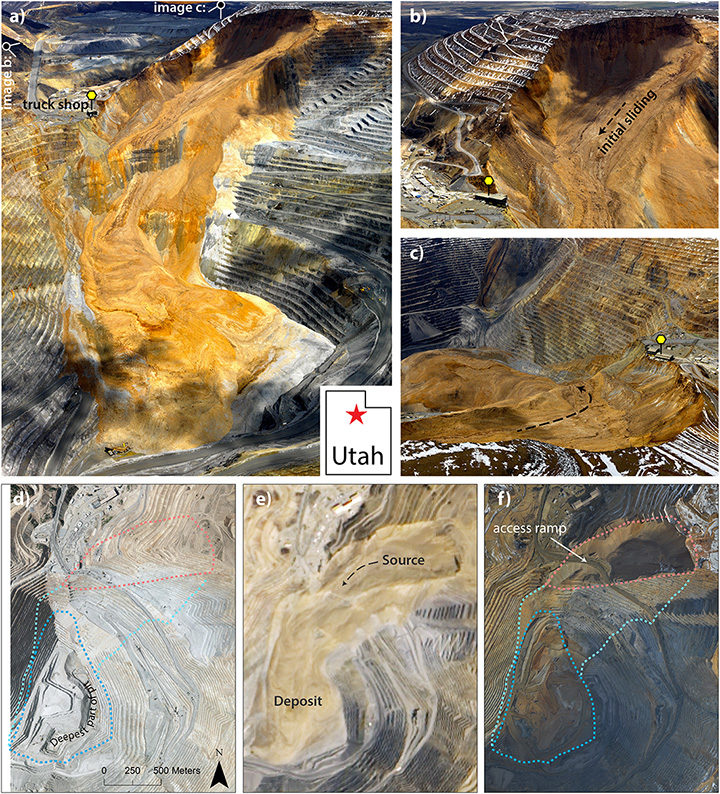
The montage was originally published in March 2017 by the Journal of Geophysical Research as part of a study authored by Jeffrey Moore of Lawrence Livermore National Laboratory. The University of Utah wrote about the research in a recent blog post:
On April 10, at 9:30 p.m. and again at 11:05 p.m., the slope gave way and thundered down into the pit, filling in part of what had been the largest man-made excavation in the world. Later analysis estimated that the landslide was at the time the largest non-volcanic slide in recorded North American history. Now, University of Utah geoscientists have revisited the slide with a combined analysis of aerial photos, computer modeling, and seismic data to pick apart the details. The total volume of rock that fell during the slide was 52 million cubic meters, they report, enough to cover Central Park with 50 feet of rock and dirt. The slide occurred in two main phases, but researchers used infrasound recordings and seismic data to discover 11 additional landslides that occurred between the two main events. Modeling and further seismic analysis revealed the average speeds at which the hillsides fell: 81 miles per hour for the first main slide and 92 mph for the second, with peak speeds well over 150 mph.
The interferometric radar system is not the only safety technology in place at Bingham Canyon. Drones, GPS, and trained experts keep a vigilant eye out for signs of landslides at this mine. Technology and tactics like this mean landslides cause very few injuries and deaths in the United States even though significant landslide potential exists in many parts of the country. As we recently reported, many other parts of the world (notably Africa and South America) are not nearly so fortunate.
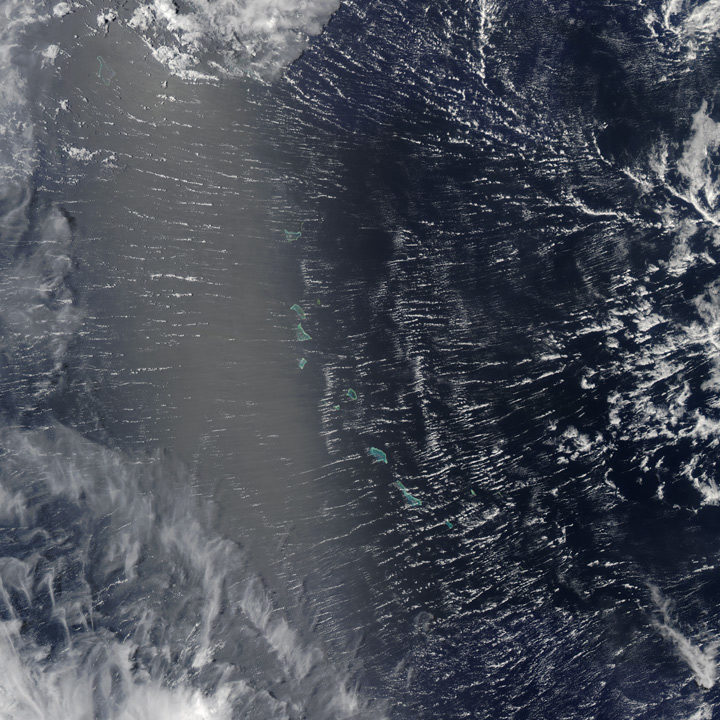
Every month on Earth Matters, we offer a puzzling satellite image. The April 2017 puzzler is above. The challenge this month, however, is slightly different. Use the comments section to tell us not only WHERE we are looking, but WHAT we are looking at. As usual, we welcome ideas about when the image was acquired, and why the scene is interesting.
How to answer. Your answer can be a few words or several paragraphs. (Try to keep it shorter than 200 words). You might simply tell us what part of the world an image shows. Or you can dig deeper and explain what satellite and instrument produced the image, what spectral bands were used to create it, or what is compelling about some obscure speck in the far corner of an image. If you think something is interesting or noteworthy, tell us about it.
The prize. We can’t offer prize money or a trip to Mars, but we can promise you credit and glory. Well, maybe just credit. Roughly one week after a puzzler image appears on this blog, we will post an annotated and captioned version as our Image of the Day. After we post the answer, we will acknowledge the person who was first to correctly ID the image at the bottom of this blog post. We may also recognize certain readers who offer the most interesting tidbits of information about the geological, meteorological, or human processes that have played a role in molding the landscape. Please include your preferred name or alias with your comment. If you work for or attend an institution that you want us to recognize, please mention that as well.
Recent winners. If you’ve won the puzzler in the last few months or work in geospatial imaging, please sit on your hands for at least a day to give others a chance to play.
Releasing Comments. Savvy readers have solved some of our puzzlers after only a few minutes or hours. To give more people a chance to play, we may wait between 24-48 hours before posting the answers we receive in the comment thread.
Good luck!
Scientists have long known that moisture content in the thin, top layers of soil plays an important role in global water processes. Recent findings published in Nature Geoscience show that roughly 14 percent of all rainfall remains in the uppermost soil layer for as long as three days after a storm. According to data from NASA’s Soil Moisture Active Passive mission (SMAP), that’s especially true for Earth’s driest regions.
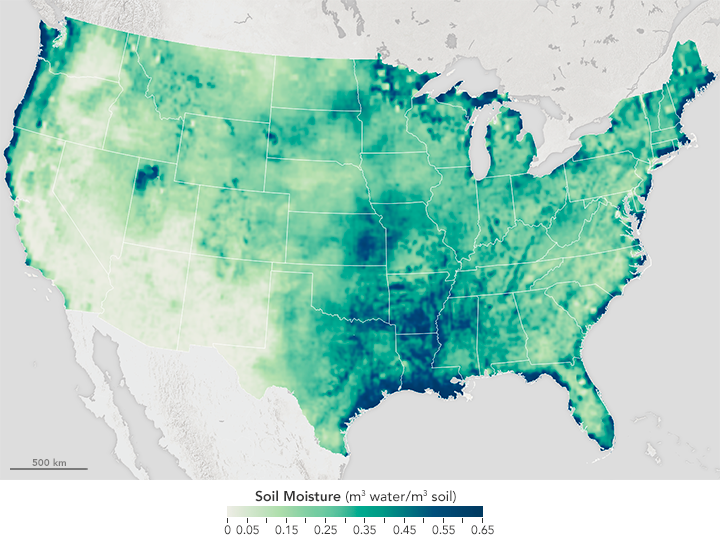
Soil moisture varied widely in this image, which uses data gathered between May 27–31, 2015. Image by Joshua Stevens/NASA Earth Observatory.
“It’s sitting at a very critical zone at the surface of the land, and plays a disproportionately critical role in the cycling of water,” said Dara Entekhabi, a professor at MIT and author of the study, in a press release. “It plays a significant role in moderating climate on seasonal and annual timescales.”
The top 2 inches (5 centimeters) of surface soil contains a sort of “memory”—even several days after a heavy rainfall, the soil will contain a fraction of that moisture. Such memory can affect weather, farming, the spread of vector-borne diseases and the length of droughts and floods.
For more on SMAP, check out some of these NASA Earth Observatory stories:
+Soil Moisture in the United States
+Soggy Soil in the Eastern United States
Decades or even centuries from now, when enough time has passed for historians to write definitive accounts of global warming and climate change, two names are likely to make it into history books: Syukuro Manabe and Richard Wetherald.
In the late-1960s, these two scientists from the Geophysical Fluid Dynamics Laboratory developed one of the very first climate models. In 1967, they published results showing that global temperatures would increase by 2.0 degrees Celsius (3.6 degrees Fahrenheit) if the carbon dioxide content of the atmosphere doubled.
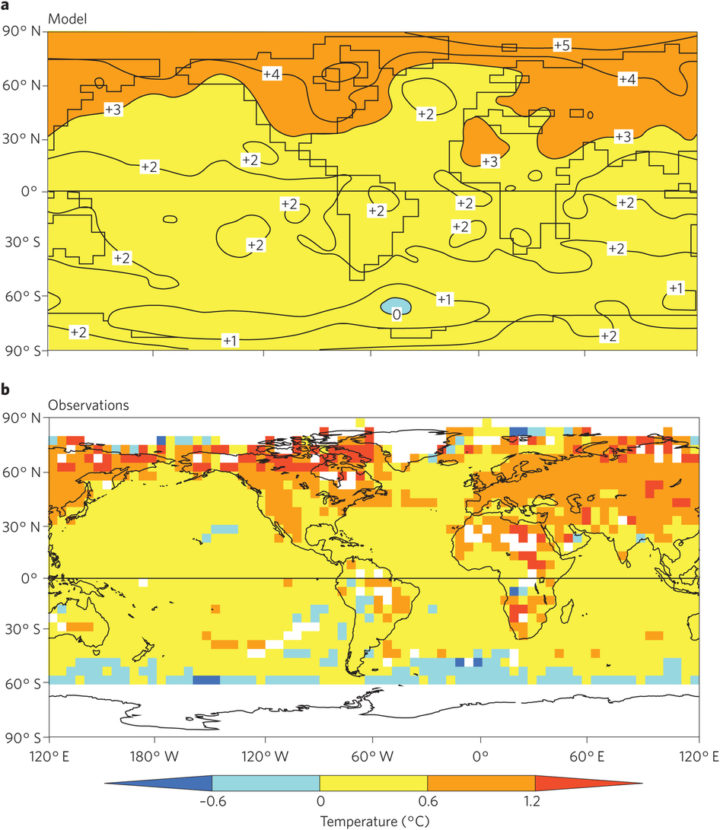
The top map shows temperature changes in one of Manabe’s coupled atmosphere–ocean models. It depicts what would happen by the 70th year of a global warming experiment when atmospheric concentrations of carbon dioxide are doubled. The model’s predictions match closely with levels of warming observed in the real world. The lower image shows observed change from a 30-year base period around 1961–1990 and 1991–2015. The map was obtained using the historical surface temperature dataset HadCRUT4. Figure published in Stouffer & Manabe, 2017.
As Ethan Siegel pointed out in Forbes, carbon dioxide content has risen by roughly 50 percent since the pre-industrial era. Observed temperatures, meanwhile, have increased by 1°C (1.8°F). For a pair of scientists working in a time when computer instructions were compiled on printed punch cards and processing was thousands of times slower than today, they created a remarkably accurate model. That is not to say that Manabe claims his 1967 model is perfect. In fact, he is quick to point out that there are some aspects that his and other climate models still get wrong. In an interview with CarbonBrief, he put it this way:
Models have been very effective in predicting climate change, but have not been as effective in predicting its impact on ecosystem[s] and human society. The distinction between the two has not been stated clearly. For this reason, major effort should be made to monitor globally not only climate change, but also its impact on ecosystem[s] through remote sensing from satellites as well as in-situ observation.
There is a great deal of fascinating detail about Manabe and Wetherald’s model and the early history of climate modeling that do not fit into a short blog post. If you want to learn more, this section of Spencer Wirt’s the History of Global Warming is well worth the time. The American Institute of Physics has also posted a Q & A with Manabe that covers his 1967 paper, which is considered one of the most influential in climate science. And in March 2017, Manabe and colleague Ronald Stouffer authored a commentary that was published in Nature Climate Change. The Independent also has a good article about this.
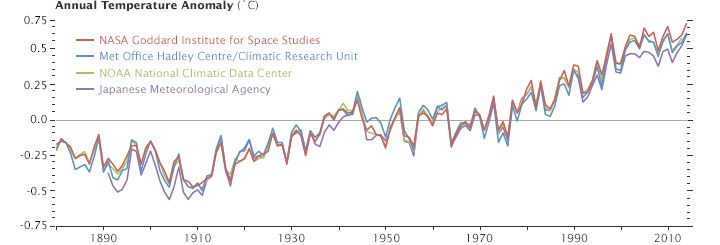
This line plot shows yearly temperature anomalies from 1880 to 2014 as recorded by NASA, NOAA, the Japan Meteorological Agency, and the Met Office Hadley Centre (United Kingdom). Though there are minor variations from year to year, all four records show peaks and valleys in sync with each other. All show rapid warming in the past few decades, and all show the last decade as the warmest. Read more about this chart.
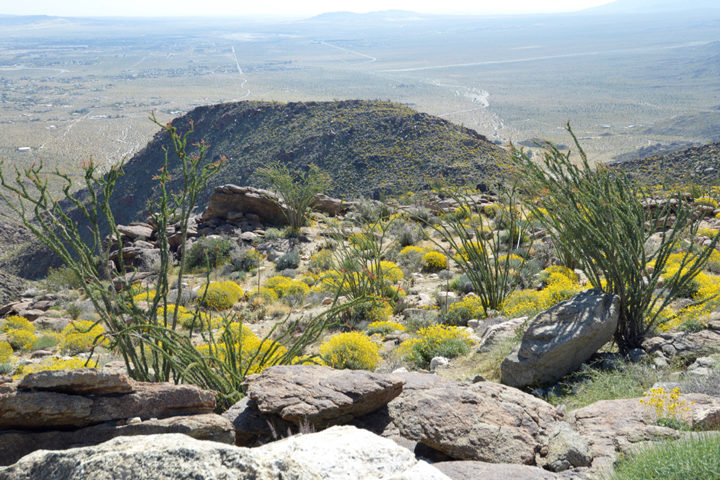
Photo by Ray Boren.
In late March 2017, California’s Colorado Desert sprang to life with vegetation following a period of ample precipitation. From space, imagery acquired on March 23 showed a widespread green up. From the ground, photographs from the same area showed the greenery topped with vibrant blooms.
Writer and avid amateur photographer Ray Boren was on location in Anza-Borrego Desert State Park to witness peak bloom, but not without a little trial and error in timing. He shared some photographs and a brief description of his journey.
“I first visited Anza-Borrego last year, in early May—a little late, I discovered, to catch the blossoms at their peak (though there were a few even then). It was already hitting 100 degrees there ….
So, when I heard that this year’s “super-bloom” in California’s largest state park was even better—enhanced by drought-busting winter and spring moisture—I had to dash the 800 or so miles from my Utah home to see what I could see. I did so with my sister Elaine, and we were well rewarded.
These photographs are from a drive through Anza-Borrego on a beautiful, even “cool” Monday, March 27, 2017.
The vista (top photo) is from Anza-Borrego’s granite mountains, which basically form a north-south spine through the huge state park. The view is from a turnoff on S22, a San Diego County road toward the park’s north side, and is looking east. From this point, you can look down upon the community of Borrego Springs, which is where Anza-Borrego’s visitor center is located (and which is quite recognizable in the satellite photos NASA Earth Observatory used as an Image of the Day).
The yellow flowers, which blanket the sunny slopes, are I believe California trixis. Gangly, multi-limbed ocotillo, with their flowering red tips, are common in the park, and they are having a grand spring.”
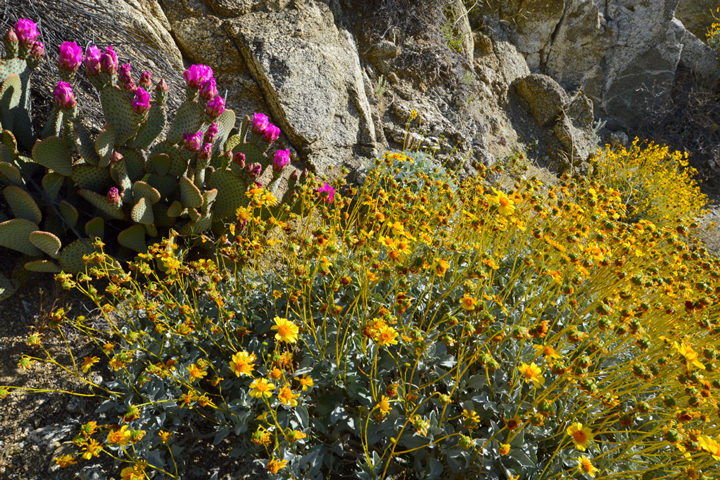
Photo by Ray Boren.
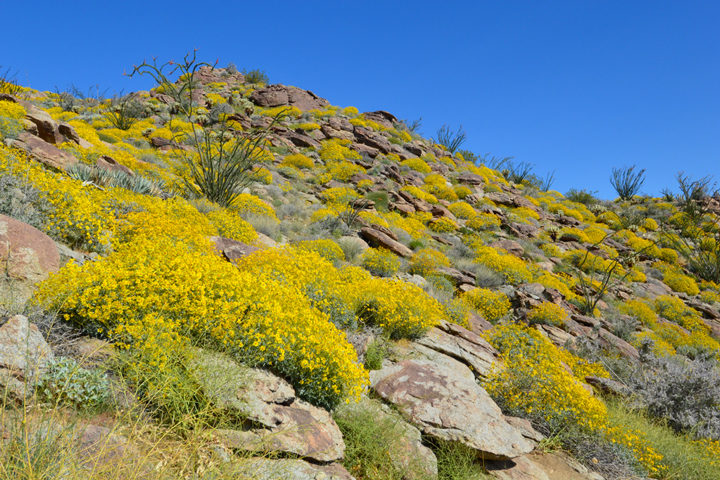
Photo by Ray Boren.
“Pictured in other photos, from the same S22 route, are beavertail cactuses, with their brilliant pink-lavender flowers just beginning to pop. The super-bloom seems most dominant on the north side of the park (we also drove south, to see the badlands). The garden at the visitor center is bursting with color, including such lovely plants as wolf’s cholla, barrel cactus and California’s squat but beautiful fan palms. We even saw a couple of Anza-Borrego’s iconic Peninsular desert sheep (“borrego”) on the ridges.
During our journey, we also saw desert flowers near the border with Nevada and Arizona, and were amazed by the bountiful show under way at the Antelope Valley California Poppy Reserve near Lancaster, which we visited on the way home.”
The Anza-Borrego Desert without wildflowers blooming. This image was acquired by the Operational Land Imager (OLI) on Landsat 8 on March 20, 2016. Learn more.
The Anza-Borrego Desert during a wildflower bloom. Notice the greens and purples around Borrego Springs. This image was acquired by the Operational Land Imager (OLI) on Landsat 8 on March 23, 2017. Learn more.
Here’s a roundup of some of the latest Earth science news from NASA.

The number of days with lethal dehydration risk rises in a future scenario where the Earth warms by 7 degrees Fahrenheit. Credit: NASA
MORE HEAT, LESS SINGING
Longer, more intense, and more frequent heatwaves threaten U.S. songbirds, according to a recent study. In a scenario where temperatures increase by 4 degrees Celsius (7 degrees Fahrenheit), five species of songbirds will become more prone to mass die-offs due to dehydration. Researchers used data from the North American Land Data Assimilation System (NLDAS) and physiological data in the study. Read more here.
CHILLING AND DRILLING UNDER EREBUS
This spring, scientists descended into ice caves below Mount Erebus—the entrance to the underworld, according to the ancient Greeks. Aaron Curtis, a postdoctoral scholar at NASA’s Jet Propulsion Laboratory, used the icy environment to test robots, a drill, and computer-aided mapping technology. The tests were intended to explore and simulate how these tools might perform on icy planets. Read more here.
SAGE WATCHES OVER OZONE
How thick is the Earth’s ozone layer now, after years of depletion, regulation, and recovery? The Stratospheric Aerosol and Gas Experiment (SAGE) III instrument is set to monitor “the Earth’s sunscreen,” as well as other gases and particles, from the International Space Station. Following its installation in March 2017, SAGE will keep a pulse on ozone, water vapor, and aerosols in our atmosphere.
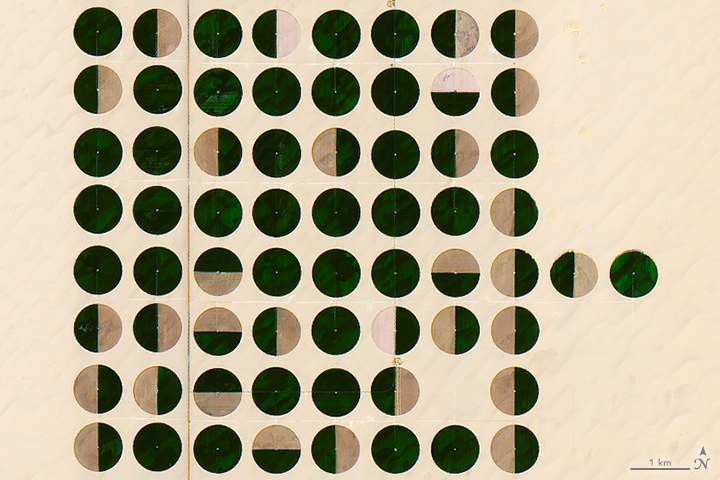
NASA Earth Observatory image by Joshua Stevens, using Landsat data from the U.S. Geological Survey.
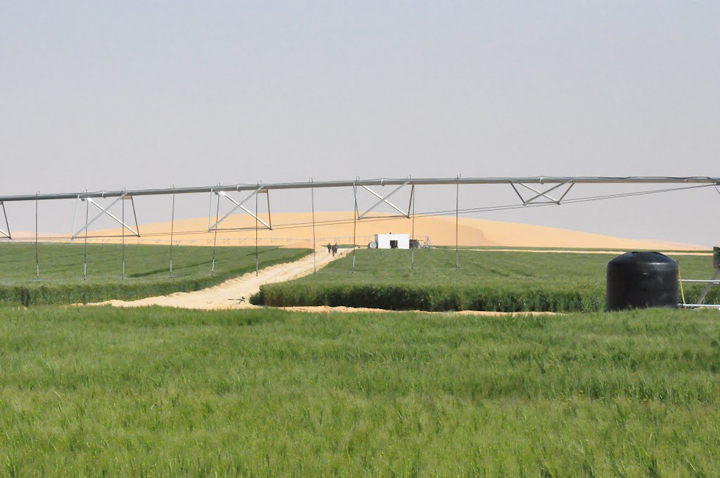
Cultivated desert. Photo by Ragab Hafiez.
In early March 2017, we featured the top image as our monthly satellite puzzler and as an Image of the Day. But sometimes we learn even more about an image after we publish, as people write to us with a local or personal connection to the place. That was the case here.
Local knowledge is especially important when it comes to agriculture. Ragab Hafiez, a hydrogeologist and geologist working for DASCO, studies Egypt’s Western Desert. He gave us permission to re-publish some of his photographs showing the ground-based view of East Owinat, one of Egypt’s land reclamation projects aimed at making some desert areas suitable for agriculture. He also took the time to answer some questions about the satellite image that inspired the puzzler.
Q: What features visible in these images strike you as interesting?
A: The features visible in these images are the irrigated crops mainly clustered in a center-pivot irrigation systems; the diameter of the pivots range from 700 to 820 meters. The total irrigated area at the beginning of this year was about 79,000 hectares.
Q: Is there anything not visible that is worth noting?
A: East Owinat is an interesting area located at the far south of Egypt. It’s an arid to hyper-arid area, the rainfall is nil, and fossil groundwater is the only source of water in the area.
The area is covered with a thin sheet of loose sand, followed by the thick sandstone rock bed. The sandstone beds belong to the Nubian sandstone formation deposited through the Lower Cretaceous and Jurassic periods.
The water wells in the area are usually drilled to depths of 200 to 350 meters (650 to 1150 feet) below the ground surface. The water level ranged from 30 to 60 meters (100 to 200 feet) below ground.
Q: Do you happen to know what crops are planted here, and the reason for the various green/brown patters?
A: The crops cultivated in the winter season are wheat, barley, potatoes, and alfalfa. Virgin soil, fresh water (salinity less than 700 parts per million), mild weather, and long daily sunlight hours are all factors that combine to produce high-quality and prolific crops.
The green areas are currently cultivated, while the brown areas are left without cultivation this season.
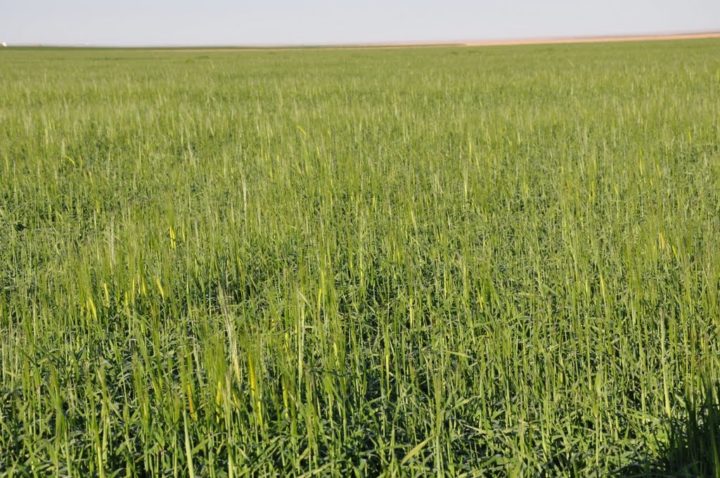
Wheat fields. Photo by Ragab Hafiez.
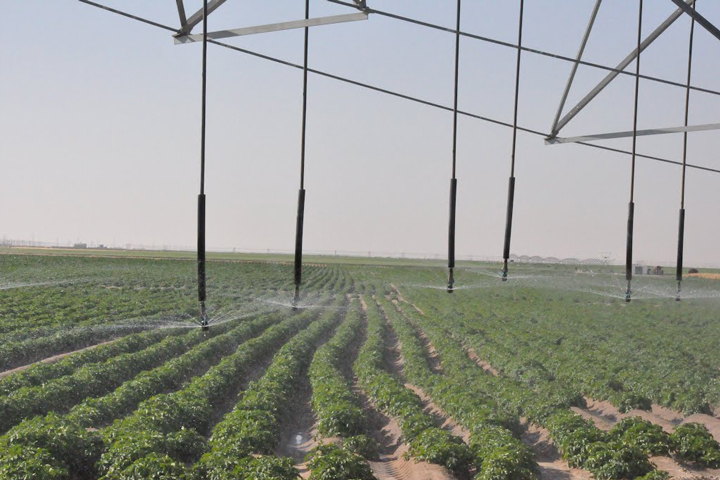
Potato fields in the desert. Photo by Ragab Hafiez.
Most NASA stories about sea ice records tend to start with the year 1979, when consistent observations started to be collected regularly by satellites. But we do know a bit about what happened before then based on aerial, ocean, and ground-based data. And now some recently recovered observations and new modeling suggest that Arctic sea ice grew for a period between 1950 and 1975.
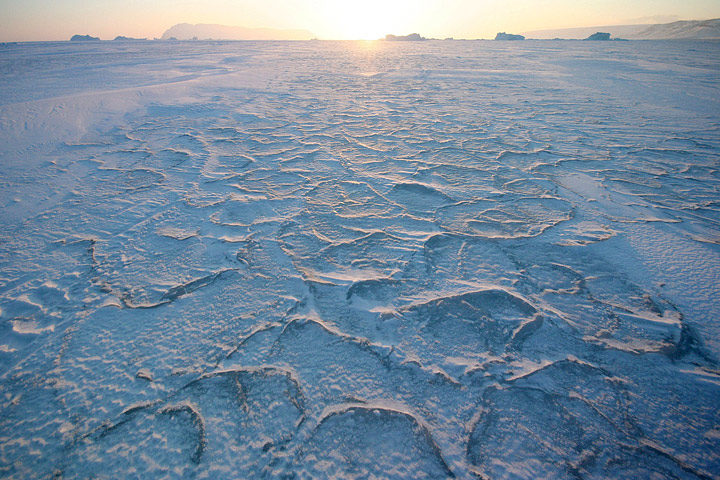
The Sun hangs low on the horizon above solidified pancake ice in the Arctic Ocean. (Photograph courtesy Andy Mahoney, NSIDC.)
A new analysis led by Marie-Ève Gagné of Environment and Climate Change Canada offers an explanation for the rise: air pollution. Gagné and colleagues showed that sulfate aerosol particles, which are released by the burning of fossil fuels, may have disguised the impact of greenhouse gases on Arctic sea ice.
In a press release, the American Geophysical Union explained more details:
These particles, called sulfate aerosols, reflect sunlight back into space and cool the surface. This cooling effect may have disguised the influence of global warming on Arctic sea ice and may have resulted in sea ice growth recorded by Russian aerial surveys in the region from 1950 through 1975, according to the new research.
“The cooling impact from increasing aerosols more than masked the warming impact from increasing greenhouse gases,” said John Fyfe, a senior scientist at Environment and Climate Change Canada and a co-author of the new study accepted for publication in Geophysical Research Letters.
To test the aerosol idea, researchers used computer modeling to simulate sulfate aerosols in the Arctic from 1950 through 1975. Concentrations of sulfate aerosols were especially high during these years before regulations like the Clean Air Act limited sulfur dioxide emissions that produce sulfate aerosols.
The study’s authors then matched the sulfate aerosol simulations to Russian observational data that suggested a substantial amount of sea ice growth during those years in the eastern Arctic. The resulting simulations show the cooling contribution of aerosols offset the ongoing warming effect of increasing greenhouse gases over the mid-twentieth century in that part of the Arctic. This would explain the expansion of the Arctic sea ice cover in those years, according to the new study.
Aerosols spend only days or weeks in the atmosphere so their effects are short-lived. The weak aerosol cooling effect diminished after 1980, following the enactment of clean air regulations. In the absence of this cooling effect, the warming effect of long-lived greenhouse gases like carbon dioxide has prevailed, leading to Arctic sea ice loss, according to the study’s authors.
Read more about aerosols and sea ice.
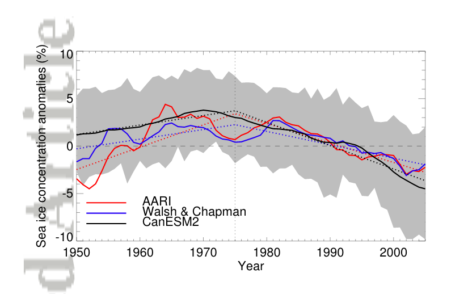
This chart, from Gagné et al, shows the area-averaged annual mean sea ice concentration anomaly between 1950 and 2005. The red line reflects Arctic and Antarctic Research Institute (AARI) data, which is based on historical sea ice charts from several sources (aircraft, ship, and satellite observations). The blue Walsh & Chapman data includes additional historical sources and uses slightly different techniques for merging various data streams. The black line is a simulated mean sea ice concentration from the CanESM2 large ensemble, a group of models developed at the Canadian Center for Climate Modelling and Analysis. Anomalies are relative to climatological averages between 1975 and 2005. The time series have been lightly smoothed with 5-year running mean. The gray shading shows the 5-95 percent range over the individual simulations of the model ensemble. The dotted lines are the piecewise linear approximated trends.